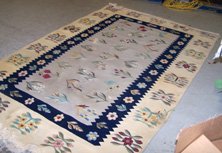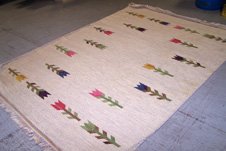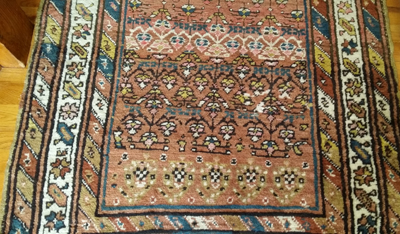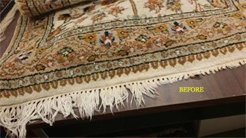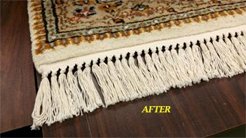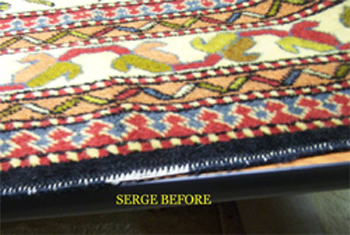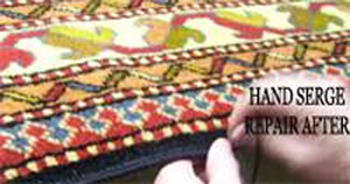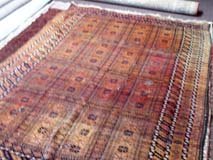ORIENTAL RUGS-
WEAVING and FINISHING
Oriental Rugs-Weaving and Finishing delves into the various ways these rugs are woven and then finished to produce the end product. A previous article, Oriental Rugs-Construction Elements, explored the use of warp and weft threads of yarn to form the foundation of the rugs and the types of knots used to tie pieces of yarn onto the foundation to form the pile. A simple explanation of the actual weaving process is explained below.
Oriental Rugs-Weaving and Finishing
The Weaving Process for
Hand Knotted Pile Rugs
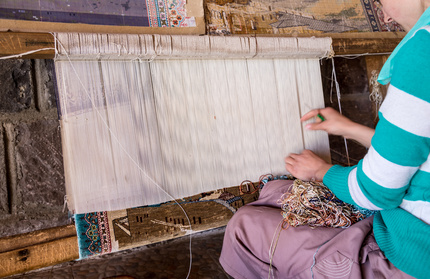
Yarns which are wrapped around a loom (either horizontal or vertical) and run the length of the rug to prepare for the weaving are called warps. Lengths of yarn are spun and plied and tied by hand onto the warps, perpendicular to them. After a row of knots has been tied horizontally on the warp cords, one or more weft threads are then inserted across on top of the knots. The weft cord or cords will then be beaten down by the weaver across the loom with a comb to secure the knots.
Weavers will usually have on hand some simple tools such as a knife with a hook, a pair of scissors, and a heavy comb to beat down the wefts and secure the knots. A skillful weaver can actually tie between 8 and 10 thousand knots in an 8 hour working day!
The weaver often has a guide, called a cartoon, which is drawn on a grid paper with colors to scale with each square representing a knot. The commercial weaving establishments rely upon the cartoon and the weavers are discouraged from making any changes. This is not the case with Village rug weavers who take great pride in personalizing their woven rugs.
Oriental Rugs-Weaving and Finishing
The Weaving Process for
Flatwoven Rugs
There are other types of hand made rugs that are often classified as Oriental Rugs. These are called Flatwoven rugs.
Flatwoven rugs do not have a pile because the weaving process does not involve tying knots. Therefore the weaving is done with a combination of warp yarns wrapped around a loom with weft yarns inserted between the warps.
Therefore, the rug design is created with a combination of the warp and weft cords, although very often it is the weft that creates the design of the rug.
Some examples of flatwoven rugs are:
- Dhurries
- Kilims (Kelims)
- Navajos
- Soumaks
- Aubussons
Because traffic on Flatwoven rugs occurs on the sides of the fiber rather than the tips (as in Oriental Rugs), they could possibly wear and abrade more quickly because there is no protection for the foundation. On the other hand, the construction of an Aubusson rug is such that it can actually be more durable than a Persian rug.
Oriental Rugs-Weaving and Finishing
Color Variations in Oriental Rugs
Color variations, known as abrash, result from a slight color difference in the dye lots used to weave the rug. If the color change is not too different, this characteristic of hand-made rugs is actually a desirable one and is often planned for by the weaver and/or dyer. This technique is often copied by manufacturers of machine made rugs and can actually enhance the three-dimensional appearance of a rug.
Oriental Rugs-
Weaving and Finishing
How Oriental Rugs are
Finished After Weaving
When the weaving is done, the rug will be cut from the loom. Most often this is done by cutting the warps at one or both ends of the rug. If more than one rug has been woven on a loom, the sides will also be cut. The fringes will be secured and the sides made stable with certain finishing processes specific to each weaver's country or preference. The pile may also be trimmed with scissors and a variety of post-manufacturing treatments may take place, including washing prior to going to market.
Finishing Stitches
The Ends (usually the shorter edges)
·After the weaving is finished and removed from the loom, the warp threads at the end are knotted, woven or braided into the fringe.
·Occasionally a flat area of varying size may be woven at the end of the rug before the fringe is finished. This is called a kilim.
·A ‘skirt’ is an additional wide border which can sometimes be found on one end of rugs such as Juvals and Donkeybags.
·The area where the rug is woven and the decision of the weaver will determine whether both ends will have a fringe treatment or just one.
NOTE: Fringes can deteriorate from wear, age, harsh chemicals, etc. At ABC, we offer various fringe repair options that can return the ends to their previous beauty.
The Sides
·These are usually the longer edges of the rug. The sides are often secured by one of a number of serging stitches. This is especially true of mass produced rugs and those that have been woven on the same loom and then cut on the sides to separate them. These will need securing and are susceptible to being torn off the rug. A touch of glue may be added to the cut edges before finishing to prevent the cut edges from popping out.
·A typical serging side finish occurs when the sides are wrapped with a separate yarn or yarns in a circular fashion, which creates a rounded finish. This is an overcast finish. Sides can have a single, double, triple or more overcast wrap which will also help in identifying the weaving region. These side finishes can be created with a single color, blocks of color changes, or a barber pole type pattern.
ABC is skilled in hand-restoring of all types of side finishes.This is shown in the repair to a serged side finish below:
Oriental Rugs-Weaving and Finishing
Washing of Rugs after
Weaving
One of the final steps in the Oriental Rugs-Weaving and Finishing process is the washing of oriental rugs. This is usually done after weaving in order to remove dust, dirt and any excess wool that may have accumulated on the surface.
Very often the rugs will go through light chemical washes for the purpose of softening the colors. Luster washes are chemical washes which are used to add a sheen or luster to the rug.
A chemical wash called an antique wash is sometimes used to bleach the color from the tips of the rugs to make them look older or antique. This deceptive practice can easily be detected by folding the rug and looking at the base of the pile. The tip of the pile will appear much lighter than the base. More information on chemically washed rugs can be found here.
ABC Can Help
Because there is a lot to learn about Oriental Rugs-Weaving and Finishing processes, even after you have gained some knowledge on this subject, you may find a rug that is just the right color and design for your home and still have a lot of questions. What is the quality of the yarn, the skill of the weaver, was the rug chemically washed, perhaps shortening its life usage, etc.?
At ABC, we can help you determine if the rug you wish to purchase is reasonably priced and can be expected to become a family heirloom.
You may visit us at 130 Cecil Malone Drive, email us at info@abcclean.com, call us at 607-272-1566, or contact us through our website at abcclean.com. We would be happy to help you in whatever way we can.
Top of Oriental Rugs - Weaving and Finishing
"The Cleanest Clean You've Ever Seen."
by
ABC Oriental Rug & Carpet Cleaning Co.
130 Cecil Malone Drive Ithaca, NY 14850
607-272-1566
